穀胱甘肽還原酶
此條目需要擴充。 (2011年9月15日) |
穀胱甘肽還原酶[1](英語:Glutathione reductase,EC 1.8.1.7)是一種將氧化型穀胱甘肽(GSSG)還原成為硫醇型穀胱甘肽的酶,而穀胱甘肽是一種重要的細胞抗氧化劑[2][3]。
對於一摩爾的氧化型穀胱甘肽(GSSG),需要一摩爾的NADPH將氧化型穀胱甘肽還原為還原型穀胱甘肽。這種酶形成一個FAD結合的同型二聚體。穀胱甘肽還原酶在所有界中都是進化保守的。在細菌、酵母與動物中,編碼穀胱甘肽還原酶的基因是同一種;然而,在植物基因組中,有兩個被編碼的穀胱甘肽還原酶。果蠅與錐體蟲甚至都沒有編碼穀胱甘肽還原酶的基因[4]。在這些生物中,穀胱甘肽還原酶的還原是分別由硫氧還蛋白以及錐蟲胱甘肽系統來完成的[4][5]。
參考文獻
編輯- ^ [1][永久失效連結]
- ^ Meister A. Glutathione metabolism and its selective modification. J. Biol. Chem. 1988, 263 (33): 17205–8 [2011-09-19]. PMID 3053703. (原始內容存檔於2009-08-17).
- ^ Mannervik B. The enzymes of glutathione metabolism: an overview. Biochem. Soc. Trans. 1987, 15 (4): 717–8. PMID 3315772.
- ^ 4.0 4.1 Kanzok SM, Fechner A, Bauer H, Ulschmid JK, Müller HM, Botella-Munoz J, Schneuwly S, Schirmer R, Becker K. Substitution of the thioredoxin system for glutathione reductase in Drosophila melanogaster. Science. 2001, 291 (5504): 643–6. PMID 11158675. doi:10.1126/science.291.5504.643.
- ^ Krauth-Siegel RL, Comini MA. Redox control in trypanosomatids, parasitic protozoa with trypanothione-based thiol metabolism. Biochim Biophys Acta. 2008, 1780 (11): 1236–48. PMID 18395526. doi:10.1016/j.bbagen.2008.03.006.
深入閱讀
編輯- Sinet PM, Bresson JL, Couturier J; et al. [Possible localization of the glutathione reductase (EC 1.6.4.2) on the 8p21 band]. Ann. Genet. 1977, 20 (1): 13–7. PMID 302667.
- Krohne-Ehrich G, Schirmer RH, Untucht-Grau R. Glutathione reductase from human erythrocytes. Isolation of the enzyme and sequence analysis of the redox-active peptide.. Eur. J. Biochem. 1978, 80 (1): 65–71. PMID 923580. doi:10.1111/j.1432-1033.1977.tb11856.x.
- Loos H, Roos D, Weening R, Houwerzijl J. Familial deficiency of glutathione reductase in human blood cells.. Blood. 1976, 48 (1): 53–62. PMID 947404.
- Tutic M, Lu XA, Schirmer RH, Werner D. Cloning and sequencing of mammalian glutathione reductase cDNA.. Eur. J. Biochem. 1990, 188 (3): 523–8. PMID 2185014. doi:10.1111/j.1432-1033.1990.tb15431.x.
- Palmer EJ, MacManus JP, Mutus B. Inhibition of glutathione reductase by oncomodulin.. Arch. Biochem. Biophys. 1990, 277 (1): 149–54. PMID 2306116. doi:10.1016/0003-9861(90)90563-E.
- Arnold HH, Heinze H. Treatment of human peripheral lymphocytes with concanavalin A activates expression of glutathione reductase.. FEBS Lett. 1990, 267 (2): 189–92. PMID 2379581. doi:10.1016/0014-5793(90)80922-6.
- Karplus PA, Schulz GE. Refined structure of glutathione reductase at 1.54 A resolution.. J. Mol. Biol. 1987, 195 (3): 701–29. PMID 3656429. doi:10.1016/0022-2836(87)90191-4.
- Pai EF, Schulz GE. The catalytic mechanism of glutathione reductase as derived from x-ray diffraction analyses of reaction intermediates.. J. Biol. Chem. 1983, 258 (3): 1752–7. PMID 6822532.
- Krauth-Siegel RL, Blatterspiel R, Saleh M; et al. Glutathione reductase from human erythrocytes. The sequences of the NADPH domain and of the interface domain.. Eur. J. Biochem. 1982, 121 (2): 259–67. PMID 7060551. doi:10.1111/j.1432-1033.1982.tb05780.x.
- Thieme R, Pai EF, Schirmer RH, Schulz GE. Three-dimensional structure of glutathione reductase at 2 A resolution.. J. Mol. Biol. 1982, 152 (4): 763–82. PMID 7334521. doi:10.1016/0022-2836(81)90126-1.
- Huang J, Philbert MA. Distribution of glutathione and glutathione-related enzyme systems in mitochondria and cytosol of cultured cerebellar astrocytes and granule cells.. Brain Res. 1995, 680 (1–2): 16–22. PMID 7663973. doi:10.1016/0006-8993(95)00209-9.
- Savvides SN, Karplus PA. Kinetics and crystallographic analysis of human glutathione reductase in complex with a xanthene inhibitor. J. Biol. Chem. 1996, 271 (14): 8101–7. PMID 8626496. doi:10.1074/jbc.271.14.8101.
- Nordhoff A, Tziatzios C, van den Broek JA; et al. Denaturation and reactivation of dimeric human glutathione reductase--an assay for folding inhibitors. Eur. J. Biochem. 1997, 245 (2): 273–82. PMID 9151953. doi:10.1111/j.1432-1033.1997.00273.x.
- Stoll VS, Simpson SJ, Krauth-Siegel RL; et al. Glutathione reductase turned into trypanothione reductase: structural analysis of an engineered change in substrate specificity. Biochemistry. 1997, 36 (21): 6437–47. PMID 9174360. doi:10.1021/bi963074p.
- Becker K, Savvides SN, Keese M; et al. Enzyme inactivation through sulfhydryl oxidation by physiologic NO-carriers. Nat. Struct. Biol. 1998, 5 (4): 267–71. PMID 9546215. doi:10.1038/nsb0498-267.
- Kelner MJ, Montoya MA. Structural organization of the human glutathione reductase gene: determination of correct cDNA sequence and identification of a mitochondrial leader sequence. Biochem. Biophys. Res. Commun. 2000, 269 (2): 366–8. PMID 10708558. doi:10.1006/bbrc.2000.2267.
- Qanungo S, Mukherjea M. Ontogenic profile of some antioxidants and lipid peroxidation in human placental and fetal tissues. Mol. Cell. Biochem. 2001, 215 (1–2): 11–9. PMID 11204445. doi:10.1023/A:1026511420505.
- Berry Y, Truscott RJ. The presence of a human UV filter within the lens represents an oxidative stress. Exp. Eye Res. 2001, 72 (4): 411–21. PMID 11273669. doi:10.1006/exer.2000.0970.
- Rhie G, Shin MH, Seo JY; et al. Aging- and photoaging-dependent changes of enzymic and nonenzymic antioxidants in the epidermis and dermis of human skin in vivo. J. Invest. Dermatol. 2001, 117 (5): 1212–7. PMID 11710935. doi:10.1046/j.0022-202x.2001.01469.x.
- Zatorska A, Józwiak Z. Involvement of glutathione and glutathione-related enzymes in the protection of normal and trisomic human fibroblasts against daunorubicin. Cell Biol. Int. 2003, 26 (5): 383–91. PMID 12095224. doi:10.1006/cbir.2002.0861.

